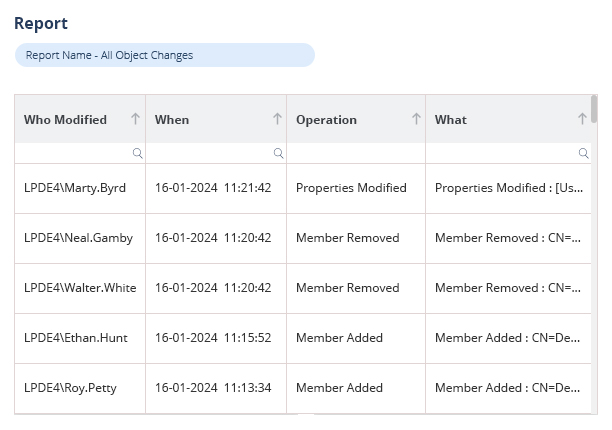
For the majority of enterprises, Active Directory has served as the foundation; controlling identities, permissions, and resource access. There is no “one size fits all” approach to configuring Active Directory because no two businesses are alike. In complex environments, administrators frequently find it difficult to manage Microsoft Active Directory efficiently.
IT managers and security experts should be aware of AD setup mistakes, that attackers frequently take advantage of to obtain initial access, raise privileges, or sustain persistence in a network. Let’s explore the most frequently observed misconfigurations in Active Directory that are found when auditing AD environments which can lead to severe consequences when exploited by malicious actors.
Top Active Directory Misconfigurations
The following are top configuration errors that occur in Active Directory environments:
- Weak Password Policies: One of the most important yet dangerous configuration mistakes is a weak password policy. Password policies govern key factors like the minimum length and complexity of passwords. Weak policies allow users to create passwords that are simple to guess or break using brute-force attacks. Not comparing the passwords to the lists of compromised credentials is another aspect of Active Directory misconfigurations. Policies that do not include this check expose the organization to credential attacks, in which hackers exploit credentials taken from one breach to illegally enter another environment. This is much easier with no account lockout policies, which enable attackers to attempt indefinitely.
- Default Configurations: A critical security issue and a serious misconfiguration are the default configurations. Notwithstanding its popularity, it is not secure enough for production environments. Rather than emphasizing security, the default configurations are designed to enable deployment and user experience. These are liberal configurations, enabled port accounts, unnecessary open ports, and easy passwords. These configurations expose mission-critical systems such as Active Directory and Entra ID and network infrastructure to risk. It is possible for an attacker to obtain the configurations if Active Directory is compromised.
- Lack of Network Monitoring: One of the essential configuration mistakes that leave the organization vulnerable to malicious activity, insider threats is lack of network monitoring. Malicious auditing can remain hidden if logging or monitoring is not adequate. The numerous issues that could result in poor network monitoring is a lack of proper tools, poor network traffic coverage, and the absence of a specialized team to interpret monitoring data. The most significant issue is that internal traffic is overlooked when the company emphasizes perimeter security and takes for granted that the internal network is safe. Critical targets are key resources such as Active Directory, which are the bases for Windows-based environments’ authorization and authentication. Organizations do not know of internal anomalies that reflect a break or criminal activity unless they have sufficient Active Directory monitoring.
- Poor User Privilege Separation: In many IT environments, poor user privilege separation is a widespread issue. Contrary to the least privilege principle, this practice often leads to the granting of administrator privileges to users who require them for routine operations. Administrative privileges are generally offered to users through local administrator access on their workstations or by putting them in privileged groups (such as Domain Admins within Active Directory). The entire network is threatened by this misconfiguration mistake. Group policies, security settings, and other critical infrastructure components can all be heavily modified by administrators or users who have administrative rights in Active Directory.
- Disabled Kerberos Pre-Authorization: Kerberos is the default authentication protocol of Active Directory. Pre-authentication is enabled by default to safeguard users from password-based attacks like brute force and password spraying attacks. Most companies disable Kerberos pre-authentication for at least one or more users. These misconfigurations will enable attacks like AS-REP roasting, in which attackers get Kerberos tickets and use them to crack password hashes offline at their convenience without fear of being detected.
- Service Accounts Over-Permissioned: A service account may be used to run one or more programs or services. Service accounts run SQL Server, SharePoint, Exchange, and Internet Information Services (IIS), for instance. Any competitor who gains hold of a service account inherits all of its permissions. If an account has too many permissions, it makes it simpler for attackers to obtain private systems and data, or even launch an attack on the entire domain. Overprovisioning of service accounts is too common. Vendors often insist that their software requires higher rights to run, but in practice, those abilities are only necessary for installation. Admins might also use their own very privileged account as a service account out of convenience, e.g., to install and test a new application quickly.
- Stale or Inactive Accounts: Inactive accounts are those that are no longer in use, either because the user has left the organization or because the service has become outdated. However, the IT teams frequently keep these accounts active. Because the hackers get access to all the rights associated with an inactive account, this Active Directory setup error presents a serious security risk. Because they have a genuine account that is unlikely to arouse suspicion and no one is logged in to observe anything strange happening, they are also free to wander about the network.
- Group Policy Objects (GPOs) Misconfigured: Another Active Directory misconfiguration relates to Group Policy, a potent part of AD and a major security tool for cyber security experts. But due to its huge potential, attackers target it too often as well. There are literally thousands of GPO options for IT admins to play around with, and complex precedence, linking, and others to figure out. This results in widespread security vulnerabilities within most organizations. In addition, one misconfigured setting can grant attackers the permission to gain access to the network, gain a higher authorization level, go undetected, or gain persistent access. Common misconfigurations include granting unlimited attempts to try to guess account passwords, making available sensitive information to groups like “All users” and “Everyone” , granting access to domain controllers to individuals who are not domain administrators.
How to Mitigate AD Misconfigurations
The following techniques can help increase cyber security and resilience by lowering active directory misconfigurations.
- Limit Service Accounts: It is crucial to strictly restrict each service account to the permissions that it actually requires to avoid active directory misconfiguration. Making a precise inventory of every Microsoft service account in your infrastructure and keeping it up to date is the first step in this procedure. Utilize the inventory to periodically check each service account’s permissions and remove any that aren’t necessary for it to operate. Additionally, administrators should not be allowed to utilize their own identities as service accounts. To improve security and control, managed service accounts (MSAs) must be employed whenever possible.
- Check Inactive Accounts: An account is considered inactive if it is not being used, it is essential to verify dormant or inactive accounts and to properly disable or delete them. Account expiration rules can be used to disable accounts that have not been accessed for a predetermined number of days, in addition to monitoring inactive accounts, to combat the active directory misconfiguration. The number of days will depend on the particular requirements of your company.
- Group Policy Strategy: The most effective approach to counteracting the active directory misconfiguration is through a group policy management plan. Periodic checking of all GPO settings, linking and validating the planned scope, enforcement of approval-based GPO change control involving the proper segregation of responsibility, and restricting the permission for creating, editing, and deleting GPOs in your environment to specific authorized users are the primary measures to be taken in order to adopt the group policy strategy.
- Re-enable Kerberos: It is crucial to confirm accounts that have Kerberos pre-authorization disabled and then enable it once more and also look for the flag. This Active Directory misconfiguration should be found on a frequent basis, ideally multiple times a day. Additionally, training must be offered in order to prevent the problem in the first place. The main issue is that the administrators neglect to re-enable Kerberos pre-authorization after disabling it for testing or debugging. In order to prevent this practice, make sure that every member of the IT team is aware of its risky security and compliance implications. Enforce this instruction by implementing a rule that prohibits anyone from turning off Kerberos pre-authorization.
How Does Lepide Help?
Lepide Active Directory auditing Tool provides a straightforward and comprehensive approach to auditing Active Directory changes, overcomes the limitations of native auditing, and ensures security. By identifying and remediating these common issues, organizations can drastically reduce their attack surface and improve overall security posture. To maintain strong security and cyber resilience, Lepide auditing tools help to follow best practices for Active Directory management, AD security, monitoring and reporting.
To secure your Active Directory and audit your configurations right away, set up a demo with one of our engineers or download a free trial.



